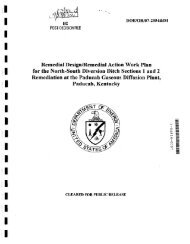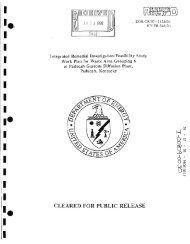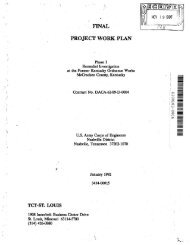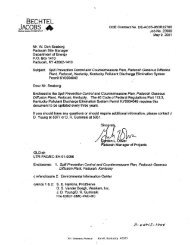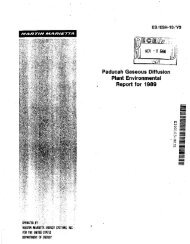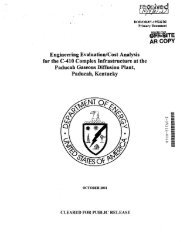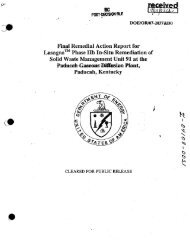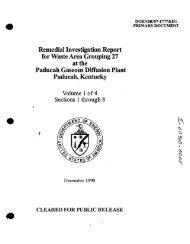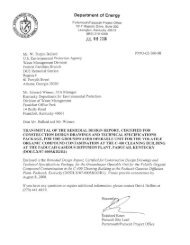1 - paducah environmental information center
1 - paducah environmental information center
1 - paducah environmental information center
You also want an ePaper? Increase the reach of your titles
YUMPU automatically turns print PDFs into web optimized ePapers that Google loves.
Annual Site Environmental Report for 1999<br />
Clean Air Act Amendments of 1990<br />
The CAA Amendments of 1990 are<br />
divided into six major titles. The two titles that<br />
could affect DOE activities at the Paducah Site<br />
are: 1) Title III, Hazardous Air Pollutants, and 2)<br />
Title VI, Stratospheric Ozone Protection.<br />
Title III, Hazardous Air Pollutants<br />
Under Section 112, requirements shifted<br />
from a pollutant-by-pollutant, health-based<br />
regulatory approach to regUlation of categories<br />
of sources using technology-based standards.<br />
Examples of hazardous air pollutants that must<br />
be regulated by the EPA include volatile organic<br />
compounds (VOCs) such as benzene, and<br />
metals such as chromium, cadmium, and<br />
manganese. The following summarizes key<br />
aspects of this legislation.<br />
A. Pollutants and Sources Subject to<br />
Regulation<br />
by virtue of its individual or total hazardous air<br />
pollutant emissions and is not currently<br />
regulated under Title III.<br />
B. Control of Accidental Releases<br />
Title III requires EPA to promulgate<br />
regulations to control and prevent accidental<br />
releases of regulated hazardous pollutants and<br />
extremely hazardous substances listed by EPA.<br />
Owners and operators of facilities where such<br />
substances are present in more than a threshold<br />
quantity were required to prepare risk<br />
management plans by June 21, 1999, for each<br />
listed sllbstance used at the facility. The Paducah<br />
Site does not store or process any of the<br />
hazardous pollutants above threshold quantities<br />
and does not require a risk management plan. If<br />
DOE decides to construct and operate the Vortec<br />
project, it would exceed the threshold of to,OOO<br />
pounds of propane and, consequently, would<br />
require a risk management plan.<br />
Title VI, Stratospheric Ozone Protection·<br />
The CAA amendments completely<br />
overhauled the regulatory approach used for air<br />
toxies. Under the new approach; 189 substances<br />
are listed by Congress for regulation. Substances<br />
can be added to or deleted from the list after rule<br />
making, but EPA need not take any action· with<br />
respect to these 189 substances.<br />
Within one year of enactment, EPA was<br />
required to publish a list of all major source<br />
categories and subcategories of the listed<br />
hazardous air pollutants, such as oil refineries<br />
and chemicai' plants. EPA issued'a list of source<br />
categories for regulation under Section 112 in<br />
July 1992. Any.stationary source emitting more<br />
than mtons/year of any of the listed substances<br />
or 25 tons/year of any combination of the<br />
substances is considered a major source and is<br />
subject to regulation. EPA must examine other<br />
sources for regulation under an "area source"<br />
program. The Paducah Site is not a major source<br />
Title VI of the 1990 amendments<br />
incorporates stratospheric ozone protection by<br />
restricting the production and consumption of<br />
chlorofluorocarbons, methyl chlorofonn, halons,<br />
carbon tetrachloride, and hydrochlorofluorocarbons.<br />
Halon, methyl chloroform,<br />
chlorofluorocarbons, and carbon tetrachloride<br />
have been phased out in DOE operations. The<br />
phaseout of hydrochlorofluorocarbons is to be<br />
accomplished over a longer period, stretching<br />
out to 2020-2040. The 1990 amendments also<br />
require that production and consumption of<br />
hydrobromofluorocarbons be phased out<br />
beginning in 1996 and that methyl bromide be<br />
added to .the list of controlled substances.<br />
DOE only has refrigeration units that<br />
contain less than 50 pounds of listed substances;<br />
therefore, the only part of this regulation that<br />
applies to the Paducah Site is the requirement to<br />
control refrigerants from leaking systems and<br />
Environmental Compliance<br />
2-15



